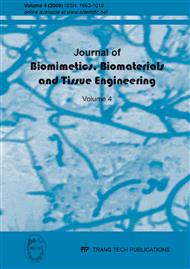p.1
p.13
p.21
p.27
p.41
p.59
p.71
Strengthening of Dense Bioceramic Samples Using Bioresorbable Polymers – A Statistical Approach
Abstract:
Mechanical properties of bioceramics are poor and need to be improved for biomedical applications. In order to do this, bioceramics may be strengthened by bioresorbable polymers. In this study, the mechanical properties of poly(ε-caprolactone), PCL, coated dense bioceramic pellets made of silica-contained calcium phosphates were studied and analyzed using a statistical experimental design in conjunction with Taguchi methods for optimization. The aim of this experimental work was to maximize the pellet flexural strength and minimize the amount of deposited PCL. The most important factors affecting the strengthening of the ceramic pellets were evaluated. Four independent processing variables (a removal technique of an excess polymer solution, concentration of PCL in the solution, a heat treatment temperature and the number of dipping) with three levels of variability were tested using an L9 (34) orthogonal array. A statistical experimental design using the analysis of means and orthogonal array was applied to optimize the responses of these variables. The optimal conditions for achieving the maximal flexural strength of the coated pellets at the minimal amount of the deposited PCL were determined. A high quality dense bioceramic pellets with ~ 10.5 MPa flexural strength and ~ 80 μm thickness (~ 21 mg weight) of the deposited PCL coating were manufactured as a result.
Info:
Periodical:
Pages:
27-39
Citation:
Online since:
December 2009
Authors:
Price:
Сopyright:
© 2009 Trans Tech Publications Ltd. All Rights Reserved
Share:
Citation:


